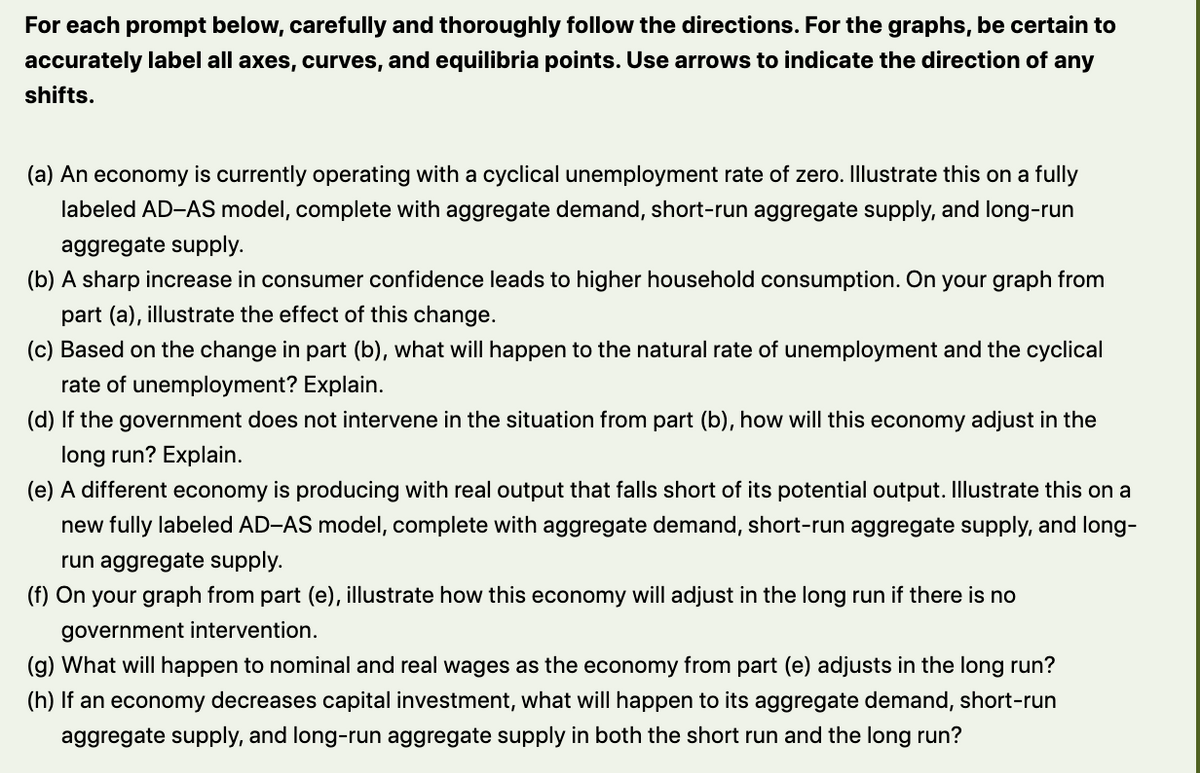For each prompt below, carefully and thoroughly follow the directions. For the graphs, be certain to accurately label all axes, curves, and equilibria points. Use arrows to indicate the direction of any shifts. (a) An economy is currently operating with a cyclical unemployment rate of zero. Illustrate this on a fully labeled AD-AS model, complete with aggregate demand, short-run aggregate supply, and long-run aggregate supply. (b) A sharp increase in consumer confidence leads to higher household consumption. On your graph from part (a), illustrate the effect of this change. (c) Based on the change in part (b), what will happen to the natural rate of unemployment and the cyclical rate of unemployment? Explain. (d) If the government does not intervene in the situation from part (b), how will this economy adjust in the long run? Explain. (e) A different economy is producing with real output that falls short of its potential output. Illustrate this on a new fully labeled AD-AS model, complete with aggregate demand, short-run aggregate supply, and long- run aggregate supply. (f) On your graph from part (e), illustrate how this economy will adjust in the long run if there is no government intervention. (g) What will happen to nominal and real wages as the economy from part (e) adjusts in the long run? (h) If an economy decreases capital investment, what will happen to its aggregate demand, short-run aggregate supply, and long-run aggregate supply in both the short run and the long run?
For each prompt below, carefully and thoroughly follow the directions. For the graphs, be certain to accurately label all axes, curves, and equilibria points. Use arrows to indicate the direction of any shifts. (a) An economy is currently operating with a cyclical unemployment rate of zero. Illustrate this on a fully labeled AD-AS model, complete with aggregate demand, short-run aggregate supply, and long-run aggregate supply. (b) A sharp increase in consumer confidence leads to higher household consumption. On your graph from part (a), illustrate the effect of this change. (c) Based on the change in part (b), what will happen to the natural rate of unemployment and the cyclical rate of unemployment? Explain. (d) If the government does not intervene in the situation from part (b), how will this economy adjust in the long run? Explain. (e) A different economy is producing with real output that falls short of its potential output. Illustrate this on a new fully labeled AD-AS model, complete with aggregate demand, short-run aggregate supply, and long- run aggregate supply. (f) On your graph from part (e), illustrate how this economy will adjust in the long run if there is no government intervention. (g) What will happen to nominal and real wages as the economy from part (e) adjusts in the long run? (h) If an economy decreases capital investment, what will happen to its aggregate demand, short-run aggregate supply, and long-run aggregate supply in both the short run and the long run?
Chapter10: Aggregate Supply
Section: Chapter Questions
Problem 1.1P
Related questions
Question
Please do parts DEF

Transcribed Image Text:For each prompt below, carefully and thoroughly follow the directions. For the graphs, be certain to
accurately label all axes, curves, and equilibria points. Use arrows to indicate the direction of any
shifts.
(a) An economy is currently operating with a cyclical unemployment rate of zero. Illustrate this on a fully
labeled AD-AS model, complete with aggregate demand, short-run aggregate supply, and long-run
aggregate supply.
(b) A sharp increase in consumer confidence leads to higher household consumption. On your graph from
part (a), illustrate the effect of this change.
(c) Based on the change in part (b), what will happen to the natural rate of unemployment and the cyclical
rate of unemployment? Explain.
(d) If the government does not intervene in the situation from part (b), how will this economy adjust in the
long run? Explain.
(e) A different economy is producing with real output that falls short of its potential output. Illustrate this on a
new fully labeled AD-AS model, complete with aggregate demand, short-run aggregate supply, and long-
run aggregate supply.
(f) On your graph from part (e), illustrate how this economy will adjust in the long run if there is no
government intervention.
(g) What will happen to nominal and real wages as the economy from part (e) adjusts in the long run?
(h) If an economy decreases capital investment, what will happen to its aggregate demand, short-run
aggregate supply, and long-run aggregate supply in both the short run and the long run?
Expert Solution
This question has been solved!
Explore an expertly crafted, step-by-step solution for a thorough understanding of key concepts.
This is a popular solution!
Trending now
This is a popular solution!
Step by step
Solved in 4 steps with 3 images

Knowledge Booster
Learn more about
Need a deep-dive on the concept behind this application? Look no further. Learn more about this topic, economics and related others by exploring similar questions and additional content below.Recommended textbooks for you



Principles of Economics 2e
Economics
ISBN:
9781947172364
Author:
Steven A. Greenlaw; David Shapiro
Publisher:
OpenStax



Principles of Economics 2e
Economics
ISBN:
9781947172364
Author:
Steven A. Greenlaw; David Shapiro
Publisher:
OpenStax